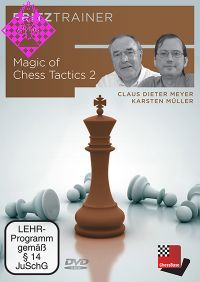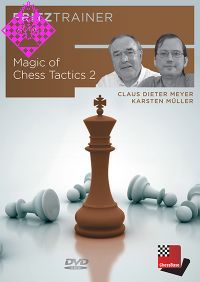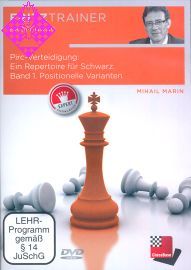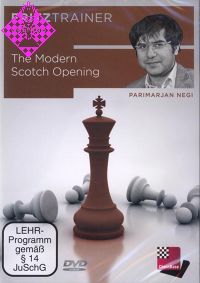Article Number
SCOLIBMTPD
Author
Master the Pirc Defense
Attributes
download, ChessBase, 1. edition 2025
This interactive video course of over 8 hours, provides an in-depth exploration of the Pirc Defence, a favoured opening for people looking to play for the win with the black pieces. Through a combination of key reference games and the analysis of a complete repertoire, this ChessBase Training video course helps you understand the essential themes, ideas, and resources needed to master this opening.
The Pirc (1.e4 d6 2.d4 Nf6 3.Nc3 g6) is a dynamic opening that temporarily allows the opponent to control the centre, only to challenge it later in a more aggressive manner. It leads to complex and often unbalanced middlegame positions, offering ample opportunities for counterplay, even against well-prepared opponents. Of course, there is an element of risk in this approach, but as the famous quote by Xavier Tartakower reminds us, "The player that takes risks may lose, the player that doesn't always loses." Through this video course, you will see that the risk is controlled when you understand the various resources of the position, making the Pirc an excellent practical choice to add to your repertoire. You will acquire a new strategic weapon for playing with the black pieces, capable of surprising your opponents, while providing real winning chances in rich and unpredictable positions.
Extensive training content and interactive exercises in ChessBase Books:
Solve exercises & and test your knowledge with the Opening Trainer & Fritz App.
Video running time:
8 hours 14 minutes (English)
7 hours 35 minutes (Francais)
The Pirc (1.e4 d6 2.d4 Nf6 3.Nc3 g6) is a dynamic opening that temporarily allows the opponent to control the centre, only to challenge it later in a more aggressive manner. It leads to complex and often unbalanced middlegame positions, offering ample opportunities for counterplay, even against well-prepared opponents. Of course, there is an element of risk in this approach, but as the famous quote by Xavier Tartakower reminds us, "The player that takes risks may lose, the player that doesn't always loses." Through this video course, you will see that the risk is controlled when you understand the various resources of the position, making the Pirc an excellent practical choice to add to your repertoire. You will acquire a new strategic weapon for playing with the black pieces, capable of surprising your opponents, while providing real winning chances in rich and unpredictable positions.
Extensive training content and interactive exercises in ChessBase Books:
Solve exercises & and test your knowledge with the Opening Trainer & Fritz App.
Video running time:
8 hours 14 minutes (English)
7 hours 35 minutes (Francais)
This interactive video course of over 8 hours, provides an in-depth exploration of the Pirc Defence, a favoured opening for people looking to play for the win with the black pieces. Through a combination of key reference games and the analysis of a complete repertoire, this ChessBase Training video course helps you understand the essential themes, ideas, and resources needed to master this opening.
The Pirc (1.e4 d6 2.d4 Nf6 3.Nc3 g6) is a dynamic opening that temporarily allows the opponent to control the centre, only to challenge it later in a more aggressive manner. It leads to complex and often unbalanced middlegame positions, offering ample opportunities for counterplay, even against well-prepared opponents. Of course, there is an element of risk in this approach, but as the famous quote by Xavier Tartakower reminds us, "The player that takes risks may lose, the player that doesn't always loses." Through this video course, you will see that the risk is controlled when you understand the various resources of the position, making the Pirc an excellent practical choice to add to your repertoire. You will acquire a new strategic weapon for playing with the black pieces, capable of surprising your opponents, while providing real winning chances in rich and unpredictable positions.
Extensive training content and interactive exercises in ChessBase Books:
Solve exercises & and test your knowledge with the Opening Trainer & Fritz App.
Video running time:
8 hours 14 minutes (English)
7 hours 35 minutes (Francais)
The Pirc (1.e4 d6 2.d4 Nf6 3.Nc3 g6) is a dynamic opening that temporarily allows the opponent to control the centre, only to challenge it later in a more aggressive manner. It leads to complex and often unbalanced middlegame positions, offering ample opportunities for counterplay, even against well-prepared opponents. Of course, there is an element of risk in this approach, but as the famous quote by Xavier Tartakower reminds us, "The player that takes risks may lose, the player that doesn't always loses." Through this video course, you will see that the risk is controlled when you understand the various resources of the position, making the Pirc an excellent practical choice to add to your repertoire. You will acquire a new strategic weapon for playing with the black pieces, capable of surprising your opponents, while providing real winning chances in rich and unpredictable positions.
Extensive training content and interactive exercises in ChessBase Books:
Solve exercises & and test your knowledge with the Opening Trainer & Fritz App.
Video running time:
8 hours 14 minutes (English)
7 hours 35 minutes (Francais)
| Weight | 100 g |
|---|---|
| Manufacturer | ChessBase |
| Medium | Download |
| Year of Publication | 2025 |
| Author | Fabien Libiszewski |
| Language | English, French |
| Edition | 1 |
| Binding | download |
| Name | ChessBase GmbH |
|---|---|
| Adresse | Osterbekstr. 90 a Hamburg 22083 Deutschland |
| Internet | www.chessbase.de |
| info@chessbase.de |
Introduction
Understanding the Pirc
Key Games to Understand the Themes
Attacking like in the King's Indian Defence
Attacking the Centre
General Knowledge and Flexibility in the Pirc
How to Defend Against a Kingside Attack?
Domination on the Dark Squares
The d6-d5 Push
Activity
The Classical Variation 1.e4 d6 2.d4 Nf6 3.Nc3 g6 4.Nf3
Main Line 4...Bg7 5.Be2 0-0 6.0-0 Nc6
Additional Options and Other 5th Moves by White
Find key moves
Repertoire Training
Practice Positions
Fianchetto Variation 1.e4 d6 2.d4 Nf6 3.Nc3 g6 4.g3
1.e4 d6 2.d4 Nf6 3.Nc3 g6 4.g3
Find key moves
Repertoire Training
Practice Positions
The 4.Bf4!? Variation 1.e4 d6 2.d4 Nf6 3.Nc3 g6 4.Bf4
1.e4 d6 2.d4 Nf6 3.Nc3 g6 4.Bf4
Find key moves
Repertoire Training
The 4.Bg5 Variation 1.e4 d6 2.d4 Nf6 3.Nc3 g6 4.Bg5
1.e4 d6 2.d4 Nf6 3.Nc3 g6 4.Bg5 c6 5th move alternatives
1.e4 d6 2.d4 Nf6 3.Nc3 g6 4.Bg5 c6 5.f4 Bg7 6.Qd2 b5 7.Bd3 0-0 8.Nf3 Bg4 9.0-0 Qb6
1.e4 d6 2.d4 Nf6 3.Nc3 g6 4.Bg5 c6 5.Qd2 Nbd7
Find key moves
Repertoire Training
Practice Positions
The Saemisch Attack 1.e4 d6 2.d4 Nf6 3.Nc3 g6 4.Be3 a6 5.Qd2 or 5.f3
1.e4 d6 2.d4 Nf6 3.Nc3 g6 4.Be3 a6 5.Qd2 or 5.f3
Find key moves
Repertoire Training
Practice Positions
The 150 Attack 1.e4 d6 2.d4 Nf6 3.Nc3 g6 4.Be3 a6 5.h3!?
1.e4 d6 2.d4 Nf6 3.Nc3 g6 4.Be3 a6 5.h3!?
Find key moves
Repertoire Training
Practice Positions
”Universal“ Variation 5.Qd2 followed by Bh6
”Universal“ Variation Against 4.Be3 / 4.Bf4 / 4.Bg5 (1.e4 d6 2.d4 Nf6 3.Nc3 g6 4.Bg5/Be3/Bf4 Bg7 5.Qd2 followed by Bh6
Repertoire Training
The 4.Be2 Variation 1.e4 d6 2.d4 Nf6 3.Nc3 g6 4.Be2
1.e4 d6 2.d4 Nf6 3.Nc3 g6 4.Be2
Find key moves
Repertoire Training
The Austrian Attack 1.e4 d6 2.d4 Nf6 3.Nc3 g6 4.f4
4...Bg7 5.e5
4...Bg7 5.Nf3 0-0 6.e5
4...Bg7 5.Nf3 0-0 6.Bd3 Nc6 7.e5
4...Bg7 5.a3 or 5.Nf3 0-0 6.a3
4...Bg7 5.Nf3 0-0 6.Be3
4...Bg7 5.Nf3 0-0 6.Be2
4...Bg7 5.Nf3 0-0 6.Bd3 Nc6 7.0-0 + Other Move Orders
Find key moves
Repertoire Training
Practice Positions
Minor Variations
1.e4 d6 2.d4 Nf6 3.f3 and 3.Nd2
1.e4 d6 2.d4 Nf6 3.Bd3
Miscellaneous 2nd moves
Repertoire Training
Conclusion
Exercises
Exercise 1
Exercise 2
Exercise 3
Exercise 4
Exercise 5
Exercise 6
Exercise 7
Bonus
Model Games
Analysis
Understanding the Pirc
Key Games to Understand the Themes
Attacking like in the King's Indian Defence
Attacking the Centre
General Knowledge and Flexibility in the Pirc
How to Defend Against a Kingside Attack?
Domination on the Dark Squares
The d6-d5 Push
Activity
The Classical Variation 1.e4 d6 2.d4 Nf6 3.Nc3 g6 4.Nf3
Main Line 4...Bg7 5.Be2 0-0 6.0-0 Nc6
Additional Options and Other 5th Moves by White
Find key moves
Repertoire Training
Practice Positions
Fianchetto Variation 1.e4 d6 2.d4 Nf6 3.Nc3 g6 4.g3
1.e4 d6 2.d4 Nf6 3.Nc3 g6 4.g3
Find key moves
Repertoire Training
Practice Positions
The 4.Bf4!? Variation 1.e4 d6 2.d4 Nf6 3.Nc3 g6 4.Bf4
1.e4 d6 2.d4 Nf6 3.Nc3 g6 4.Bf4
Find key moves
Repertoire Training
The 4.Bg5 Variation 1.e4 d6 2.d4 Nf6 3.Nc3 g6 4.Bg5
1.e4 d6 2.d4 Nf6 3.Nc3 g6 4.Bg5 c6 5th move alternatives
1.e4 d6 2.d4 Nf6 3.Nc3 g6 4.Bg5 c6 5.f4 Bg7 6.Qd2 b5 7.Bd3 0-0 8.Nf3 Bg4 9.0-0 Qb6
1.e4 d6 2.d4 Nf6 3.Nc3 g6 4.Bg5 c6 5.Qd2 Nbd7
Find key moves
Repertoire Training
Practice Positions
The Saemisch Attack 1.e4 d6 2.d4 Nf6 3.Nc3 g6 4.Be3 a6 5.Qd2 or 5.f3
1.e4 d6 2.d4 Nf6 3.Nc3 g6 4.Be3 a6 5.Qd2 or 5.f3
Find key moves
Repertoire Training
Practice Positions
The 150 Attack 1.e4 d6 2.d4 Nf6 3.Nc3 g6 4.Be3 a6 5.h3!?
1.e4 d6 2.d4 Nf6 3.Nc3 g6 4.Be3 a6 5.h3!?
Find key moves
Repertoire Training
Practice Positions
”Universal“ Variation 5.Qd2 followed by Bh6
”Universal“ Variation Against 4.Be3 / 4.Bf4 / 4.Bg5 (1.e4 d6 2.d4 Nf6 3.Nc3 g6 4.Bg5/Be3/Bf4 Bg7 5.Qd2 followed by Bh6
Repertoire Training
The 4.Be2 Variation 1.e4 d6 2.d4 Nf6 3.Nc3 g6 4.Be2
1.e4 d6 2.d4 Nf6 3.Nc3 g6 4.Be2
Find key moves
Repertoire Training
The Austrian Attack 1.e4 d6 2.d4 Nf6 3.Nc3 g6 4.f4
4...Bg7 5.e5
4...Bg7 5.Nf3 0-0 6.e5
4...Bg7 5.Nf3 0-0 6.Bd3 Nc6 7.e5
4...Bg7 5.a3 or 5.Nf3 0-0 6.a3
4...Bg7 5.Nf3 0-0 6.Be3
4...Bg7 5.Nf3 0-0 6.Be2
4...Bg7 5.Nf3 0-0 6.Bd3 Nc6 7.0-0 + Other Move Orders
Find key moves
Repertoire Training
Practice Positions
Minor Variations
1.e4 d6 2.d4 Nf6 3.f3 and 3.Nd2
1.e4 d6 2.d4 Nf6 3.Bd3
Miscellaneous 2nd moves
Repertoire Training
Conclusion
Exercises
Exercise 1
Exercise 2
Exercise 3
Exercise 4
Exercise 5
Exercise 6
Exercise 7
Bonus
Model Games
Analysis
More from ChessBase








